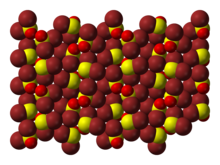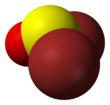Chemistry:Thionyl bromide
| |||

| |||
| Names | |||
|---|---|---|---|
| IUPAC name
Thionyl bromide
| |||
| Other names
Sulfur oxy dibromide
| |||
| Identifiers | |||
3D model (JSmol)
|
|||
| ChemSpider | |||
| EC Number |
| ||
PubChem CID
|
|||
| UNII | |||
| |||
| |||
| Properties | |||
| SOBr2 | |||
| Molar mass | 207.87 g/mol | ||
| Appearance | colorless liquid | ||
| Density | 2.688 g/mL, liquid | ||
| Melting point | −52 °C (−62 °F; 221 K) | ||
| Boiling point | 68 °C (154 °F; 341 K) at 40 mmHg | ||
| decomposes | |||
| Solubility | reacts in HBr, acetone, and alcohol soluble in benzene, toluene, ether | ||
| Structure | |||
| trigonal pyramidal | |||
| Hazards[1] | |||
| Main hazards | Readily decomposes in air to toxic gases | ||
| Safety data sheet | "External MSDS" | ||
| GHS pictograms |  
| ||
| GHS Signal word | Danger | ||
| H312, H314, H332 | |||
| P280, P305+351+338, P310 | |||
| Flash point | Non-flammable | ||
| Related compounds | |||
Related compounds
|
SOCl2, SeOCl2; | ||
Except where otherwise noted, data are given for materials in their standard state (at 25 °C [77 °F], 100 kPa). | |||
| Infobox references | |||
Thionyl bromide is the chemical compound SOBr2. It is less stable and less widely used than its chloride analogue, thionyl chloride. It is prepared by the action of hydrogen bromide on thionyl chloride,[2] a characteristic reaction where a stronger acid is converted to a weaker acid:
- SOCl2 + 2 HBr → SOBr2 + 2 HCl
Thionyl bromide will convert alcohols to alkyl bromides and can be used for brominations of certain α,β-unsaturated carbonyl compounds.[3] It may occasionally be used as a solvent.[4][5]
Safety
SOBr2 hydrolyzes readily in air to release dangerous fumes of sulfur dioxide and hydrogen bromide.
- SOBr2 + H2O → SO2 + 2 HBr
References
- ↑ "Thionyl bromide". Sigma Aldrich. https://www.sigmaaldrich.com/AU/en/product/ALDRICH/251259.
- ↑ Booth, Harold Simmons (1939). Inorganic syntheses. Volume 1. New York. p. 113. ISBN 978-0-470-13264-7. OCLC 86223179.
- ↑ Saraf, S. D. (1 August 1969). "Reaction of thionyl bromide with tropolone and phenol". Canadian Journal of Chemistry 47 (15): 2803–2804. doi:10.1139/v69-465.
- ↑ Furlani, C.; Zinato, E. (May 1967). "Hexahalogenoniobates(V), Oxopentahalogenoniobates(V) and their electronic spectra". Zeitschrift für anorganische und allgemeine Chemie 351 (3–4): 210–218. doi:10.1002/zaac.19673510311.
- ↑ The chemistry of the actinide and transactinide elements. Volumes 1-6 (4th ed.). Dordrecht: Springer. 2010. p. 526. ISBN 978-94-007-0211-0.
Mundy, B. P. (2004). "Thionyl Bromide". in Paquette, E.. Encyclopedia of Reagents for Organic Synthesis. New York: J. Wiley & Sons. doi:10.1002/047084289X.rt098. ISBN 0471936235.
 |



